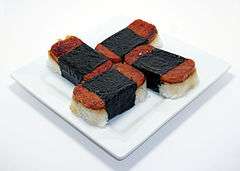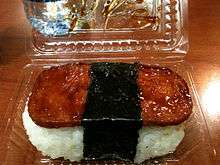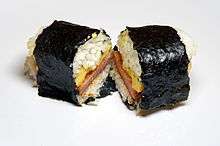Spam musubi
 Spam musubi made from Spam and rice | |
| Course | Snack |
|---|---|
| Place of origin | Japan |
| Region or state | Okinawa |
| Serving temperature | Hot or cold |
| Main ingredients | Spam, rice, nori, soy sauce |

Spam musubi is a popular snack and lunch food in Hawaii composed of a slice of grilled Spam on top of a block of rice, wrapped together with nori in the tradition of Japanese omusubi.
Inexpensive and portable, Spam musubi are commonly found near cash registers in convenience stores all over Hawaii.
Spam has become so ubiquitous in Hawaii that Spam dishes range from the cheap and fast at 7-Eleven (which also sells sushi in Hawaii[1]), served on catering trays at formal events, to homemade Spam made by celebrity chefs such as Alan Wong at his exclusive restaurants.[2]
History
Spam became a popular food in Hawaii after World War II. Spam was a main course for the troops during the war, and the large military presence in Hawaii led to Spam's widespread local adoption. Japanese Americans in Hawaii created the Spam musubi as a result.
The origin of the dish is credited to Barbara Funamura, who died on May 12, 2016 at the age of 78.[3]
Preparation
Typical preparation begins with grilling slices of spam, sometimes with a light teriyaki flavor. Then, an acrylic mold (often the shape of a slice of Spam) is then placed over a long, narrow piece of nori and rice is pressed into the mold. The grilled spam is placed over the rice before the mold is removed. The nori is then wrapped over the top and around the musubi. It is served sometimes with soy sauce or Japanese mayonnaise.
Variants

Similar to the Japanese onigiri, variations on the traditional Spam musubi exist.
The following are just a few examples of the limitless variations:
- Furikake mixed into the rice
- Scrambled egg added between the Spam and rice
- Takuan added between the Spam and rice
The spam may also be replaced with hot dog, fried shrimp, chicken teriyaki, chicken katsu, pork cutlet, Portuguese sausage (linguiça), char siu (roast pork), or other proteins instead of Spam.
See also
- Cuisine of Hawaii
- Loco moco, another Hawaiian dish that can involve rice and Spam
References
- ↑ "Party Platters and Tailgate Packs". 7-Eleven Hawaii.
- ↑ Chew, Cynthia. "The Land of SPAM". The Food Pornographer.
- ↑ "Barbara Funamura, creator of Spam musubi, dies at 78". Nichi Bei.
- Jones, Jay (March 28, 2014). "In Hawaii, it's Spam morning, noon and night". The Dallas Morning News. Retrieved 25 September 2014.
- "Spam Musubi, Obama's Hawaiian Lunch: History, Recipes, Video". The Huffington Post. 22 December 2008. Retrieved 25 September 2014.
- Robb Walsh (3 March 2009). "Obama's Lunch Fave: Spam Musubi". Eating Our Words. Retrieved 25 September 2014.
- "High-end items in New York now include Spam musubi". Retrieved 25 September 2014. (subscription required)